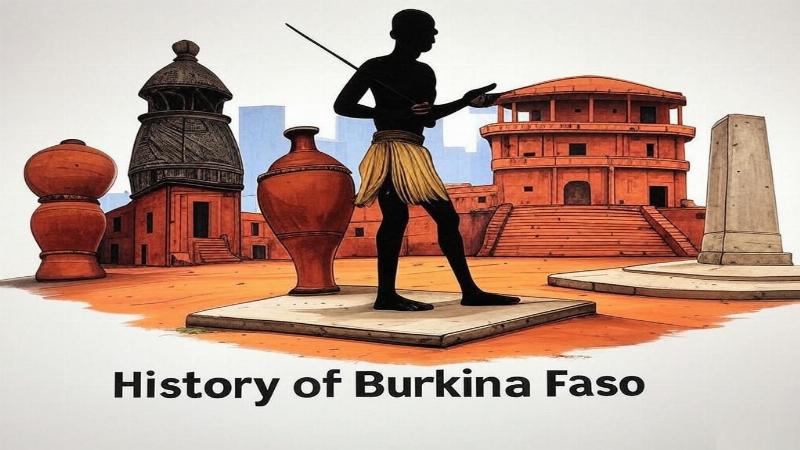Place for ads

Burkina Faso, a landlocked nation in the heart of West Africa, is a country where savanna winds carry tales of ancient empires and modern struggles. Covering 274,200 square kilometers, it sits between Mali, Niger, Benin, Togo, Ghana, and Ivory Coast, its dusty plains and vibrant markets shaping its soul. Known today for its cultural richness and political upheavals, Burkina Faso’s history blends Mossi kingdoms, colonial scars, and a quest for identity. In this article, we’ll trace Burkina Faso’s past, from its earliest days to its contemporary challenges, uncovering the milestones that define this enduring land.
Burkina Faso’s human story begins around 12,000 BCE, with hunter-gatherers roaming its Sahel fringes. Rock engravings near Pobe-Mengao—dated to 5000 BCE—depict cattle and hunters, hinting at a nomadic life tied to the Sahara’s greener past. By 3000 BCE, Neolithic farmers settled, leaving pottery shards near Douroula.
The Iron Age (500 BCE) brought smelting—tools at Oubri show early metallurgy. Bantu migrations from the south and Saharan tribes from the north mingled, birthing groups like the Gurunsi and Lobi. These peoples fished, farmed millet, and traded salt, laying ethnic roots for Burkina Faso’s diversity—over 60 groups today.
By
Place for ads
Mossi rulers, or Mogho Naaba, blended animism with governance—stone walls at Loropeni (a UNESCO site) hint at trade hubs for gold and kola nuts. Resisting Islam, they kept traditions alive, their griots reciting oral histories. By the 16th century, Mossi states thrived, a patchwork of power in the Volta basin.
The 18th and 19th centuries saw Mossi dominance—Ouagadougou’s Naaba ruled a loose federation, taxing caravans crossing to Timbuktu. Fulani jihads from the north tested them—Sokoto’s Usman dan Fodio raided in the 1810s—but Mossi horsemen held firm. Lobi and Gurunsi in the southwest resisted centralization, wielding bows against invaders.
Trade linked Burkina Faso to the Atlantic—cowrie shells and cloth flowed south, gold north. Villages like Bani, with its seven mosques, reflected wealth, though slavery scarred the land—captives fed coastal ports. This era ended abruptly with Europe’s scramble for Africa.
In 1896, French captain Paul Voulet seized Ouagadougou, burning the palace—Naaba Wobgo fled, ending Mossi independence. By 1904, the region joined French West Africa as Upper Volta, named for the Volta River’s headwaters. Colonial rule redrew borders, splitting Mossi lands with Ghana.
France exploited Upper Volta—forced labor built railways, and cotton drained fields. World War I and II drafted thousands—10,000 died in Europe’s trenches. Resistance flared—1920s revolts in Bobo-Dioulasso failed, but chiefs like Naaba Koom II subtly defied taxes. In 1932, France dissolved Upper Volta, merging it with Ivory Coast, only to restore it in 1947.
Post-war, nationalism surged—Maurice Yaméogo’s RDA party pushed for freedom. In 1958, Upper Volta gained autonomy within the French Community—Yaméogo became president at independence on August 5, 1960. Early years stumbled—coups rocked the nation, with Lt. Col. Sangoulé Lamizana seizing power in 1966.
The 1970s saw drought devastate the Sahel—hundreds of thousands died, spurring migration to Ivory Coast. Lamizana’s 1980 ouster led to chaos—Col. Saye Zerbo fell in 1982, then Jean-Baptiste Ouédraogo in 1983. Thomas Sankara’s 1983 coup marked a revolutionary turn.
Captain Thomas Sankara, at 33, renamed Upper Volta “Burkina Faso” in 1984—meaning “Land of Upright People” in Mossi and Dioula. His Marxist vision vaccinated 2.5 million kids, planted trees against desertification, and built schools—literacy soared. Women gained rights, and corruption faced the axe.
Sankara’s charisma shone—he shunned luxury, rode a bike—but his reforms alienated elites. On October 15, 1987, Blaise Compaoré, his ally, staged a coup, killing Sankara—France’s shadow loomed. Compaoré ruled 27 years, undoing much of Sankara’s legacy, though stability held.
Compaoré’s 2014 bid to extend power sparked riots—protesters burned parliament, forcing him to flee. A 2015 transitional government led to Roch Kaboré’s election—hope flickered, but jihadist attacks from Mali spilled over. Since 2016, over 2,000 have died, displacing 1.5 million in the Sahel.
Today, Burkina Faso’s 22 million people face crisis—gold mines fund growth, but poverty grips 40%. Lt. Col. Paul-Henri Damiba’s 2022 coup ousted Kaboré, only for Capt. Ibrahim Traoré to topple him months later. Culture endures—masks, balafons, and FESPACO film festival shine amid strife.
Burkina Faso’s history is a West African epic—from Mossi riders to French chains, Sankara’s fire to modern storms. Its savanna whispers of ancient valor, its cities pulse with defiance. As Burkina Faso strides forward, its past fuels a legacy of courage and continuity.
Place for ads